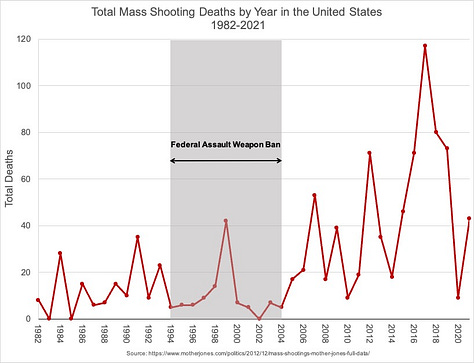What We Mean When We Say...Mass Shooting vs Active Shooting
And why you shouldn't conflate the two.
Scott Charles is the Trauma Outreach Manager at Temple University Hospital and is also one of my favorite follows on Twitter because he seemingly produces a witty retort to every one of his trolls. One such individual recently recently got into an argument with Scott over whether largest mass shooting in American history was accomplished with pistols (it was not).
The tweeter then pointed to a 2018 Trace article, triumphantly noting that “…it is pistols that are used in the majority of mass shootings!!!” (three exclamation points his). This error is a fairly common definitional error that is definitely worth noting and discussing.
Perhaps you have seen some of the below graphs at some point, each of which makes the same error. The tweeter and these graphs all use the phrase “Mass Shooting” when they really mean “Active Shooting”, and that one word makes all the difference.



The phrases “active shootings” and “mass shootings” are most decidedly not interchangeable. Active shootings have a very specific definition that is clearly spelled out in the FBI report (more on that in a second). Mass shootings have a bit fuzzier definition, but the Gun Violence Archive’s definition of a mass shooting as any incident with 4 or more victims is generally accepted.
The definition of active shootings, by contrast, points to incidents which involve “one or more individuals actively engaged in killing or attempting to kill people in a populated area… The active aspect of the definition inherently implies the ongoing nature of an incident and thus the potential for a response to affect the outcome.”
The Trace article from 2018 mentioned above references an annual report written by the FBI and researchers at Texas State University titled “Active Shooter Incidents in the United States.” These reports have been written every year since 2013 and provide data on all active shootings since 2000 (the 2022 version just came out a few weeks ago).
In order to determine if an incident is an active shooting, researchers consider a number of factors, including:
“Shootings in public places.
Shootings occurring at more than one location.
Shootings where the shooter’s actions were not the result of another criminal act.
Shootings resulting in a mass killing.
Shootings indicating apparent spontaneity by the shooter.
Shootings where the shooter appeared to methodically search for potential victims.
Shootings that appeared focused on injury to people, not buildings or objects.”
Incidents are excluded if they involve self-defense, gangs or drugs, hostage situations, domestic disputes, people are shot in the crossfire of another criminal act, or “an action that appeared not to have put other people in peril.”
It is terrific that the FBI and Texas State put this list together each year and it is good information to track. That said, the identification of active shootings is somewhat subjective and does not include the vast majority of gun violence in the US each year.
Mass shooting victims made up roughly 6 percent of all shooting victims last year in 2022 while active shooting victims made up less than 0.5 percent.
In New Orleans, for example, there were over 700 shooting incidents in 2022 with 11 of them fitting the definition of “mass shooting” per the Gun Violence Archive, but there were no “active shootings” in New Orleans last year. Indeed, there has not been a single active shooting in New Orleans this century according to the FBI/Texas State data. This is not an error, it simply reflects the nature of gun violence in New Orleans does not match the strict definition of active shooting as applied by the FBI and Texas State.
To be clear, the FBI and Texas State researchers are not responsible for conflating the two — a simple keyword search of their 2022 analysis brings up no mention of the phrase “mass shooting.” Most active shootings last year were not even mass shootings. There were 3 or fewer victims in 26 of the 50 active shootings recorded last year including 11 active shooting incidents where nobody was shot.
Yet these two concepts are constantly being used as though they are interchangeable.
It is important to track active shootings and the researchers at Texas State do good work. But it would also be nice if folks using their work would recognize the definitional difference between active and mass shootings and use those phrases accordingly.




